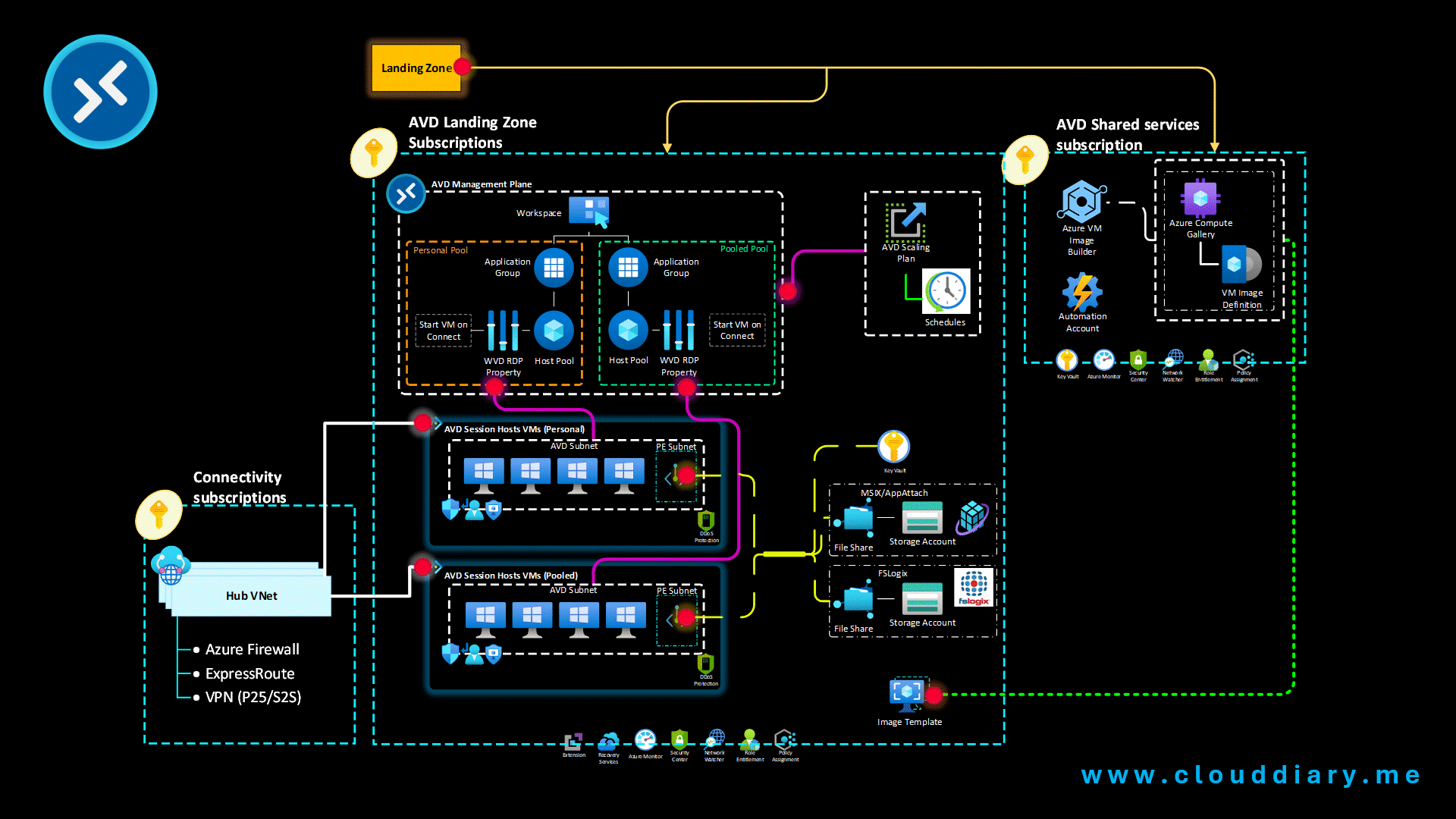- Home
- Azure Virtual Desktop
- How AVD Facilitates Digital Transformation and Cloud-First Strategies🖥️
How AVD Facilitates Digital Transformation and Cloud-First Strategies🖥️
How Azure Virtual Desktop (AVD) Facilitates Digital Transformation and Cloud-First Strategies
In today’s fast-paced digital world, organizations are increasingly embracing digital transformation and cloud-first strategies to stay competitive and agile. Azure Virtual Desktop (AVD) plays a pivotal role in this transformation, offering numerous benefits that align perfectly with modern business needs. Here’s how AVD can help organizations on this journey.
Flexibility and Scalability
One of the core advantages of AVD is its inherent flexibility and scalability. Organizations can quickly adjust their virtual desktop infrastructure to match their evolving needs, ensuring that resources are always optimally allocated. This capability is particularly valuable in dynamic business environments where demand can fluctuate significantly.
- 🏗️ Benefit: Easily scale up or down based on demand.
- 💡Impact: Avoid over-provisioning, leading to cost efficiency and optimal resource utilization.
Cost Savings
Moving to AVD can lead to substantial cost savings. By leveraging Microsoft’s cloud infrastructure, organizations can minimize their investment in physical hardware and reduce the associated maintenance and operational costs. The pay-as-you-go pricing model ensures that organizations only pay for what they use, eliminating unnecessary expenses.
- 💰 Benefit: Reduced need for on-premises infrastructure and maintenance.
- 📉 Impact: Lower capital and operational expenditures.
Remote Work Enablement
The shift towards remote work has been accelerated by global events, and AVD is perfectly suited to support this transition. AVD allows employees to access their work desktops and applications securely from anywhere, fostering a productive and flexible work environment.
- 🌍 Benefit: Secure, remote access to work desktops and applications.
- 📈 Impact: Enhanced employee productivity and satisfaction, with the ability to work from any location.
Enhanced Security
Security is a paramount concern for any organization undergoing digital transformation. AVD offers robust security features, including multi-factor authentication (MFA), conditional access policies, and data encryption. These features ensure that organizational data is protected, regardless of where the users are accessing it from.
- 🛡️ Benefit: Advanced security features to protect data.
- 🔒 Impact: Reduced risk of data breaches and enhanced compliance with regulatory requirements.
Simplified IT Management
Managing a traditional desktop environment can be complex and resource-intensive. AVD simplifies IT management by centralizing the control of virtual desktops and applications. IT administrators can easily deploy, update, and manage desktops from a single interface, reducing the administrative burden.
- 🖥️ Benefit: Centralized management of desktops and applications.
- ⚙️ Impact: Reduced IT overhead and streamlined operations.
Improved Business Continuity
AVD helps ensure business continuity by providing a reliable and resilient infrastructure. In the event of a disaster or unexpected downtime, users can continue to access their desktops and applications without interruption, minimizing the impact on business operations.
- 🔄 Benefit: High availability and disaster recovery capabilities.
- 🚀 Impact: Sustained business operations and minimal downtime.
Integration with Microsoft Ecosystem
Being a part of the Microsoft ecosystem, AVD seamlessly integrates with other Microsoft services and applications, such as Office 365, Azure Active Directory, and Microsoft Endpoint Manager. This integration enhances productivity and ensures a cohesive user experience.
- 🔗 Benefit: Seamless integration with Microsoft services.
- 🌐 Impact: Enhanced productivity and a unified user experience.
Let’s have a Look on Azure Virtual Desktop Architecture
The architecture diagram represents a well-architected AVD environment with various interconnected components ensuring seamless operation, security, and scalability. Each component plays a crucial role in delivering a robust virtual desktop infrastructure. Here’s a step-by-step explanation:

Key Components and Their Roles
AVD Management Plane
- Role: Central management interface for AVD environments.
- Benefits: Simplifies deployment, scaling, and maintenance of virtual desktops.
Host Pools
- Role: Collection of one or more identical virtual machines (VMs) used to host virtual desktops.
- Benefits: Centralized management of VMs, load balancing, and easier scaling.
Application Group
- Role: Logical grouping of applications installed on session hosts.
- Benefits: Simplifies application deployment and management, allows app virtualization
Workspace
- Role: User access point to AVD resources.
- Benefits: Provides a single, organized view for users to access all their Application groups
AVD Session Hosts VMs (Personal & Pooled)
- Role: Virtual machines that provide the actual desktops to users.
- Benefits: Flexibility in providing either personal (dedicated) or pooled (shared) desktops.
AVD Vnet
- Role: Virtual network segment for AVD VMs.
- Benefits: Ensures secure and efficient network traffic flow.
Storage Account & File Share
- Role: Storage solutions for user profiles, FSLogix containers, and other data.
- Benefits:When using with AVD, Azure File share can be use for Central roaming profiles and data redundancy.
FSLogix
- Role: FSLogix enhances and enables a consistent experience for Windows user profiles in virtual desktop computing environments.
- Benefits: Optimizes user profile loading times, ensures consistent user experience.
Azure Compute Gallery & VM Image Builder
- Role: Creation and management of AVD VM images.
- Benefits: Simplifies VM image management and deployment.
Azure Monitor
- Role: Monitoring and alerting for AVD resources.
- Benefits: Proactive management through monitoring and alerts.
Azure Virtual Desktop is a powerful tool for organizations moving towards digital transformation and cloud-first strategies. Its flexibility, cost savings, security features, and ease of management make it an ideal solution for modern businesses. By leveraging AVD, organizations can create a more agile, efficient, and secure IT environment, driving innovation and growth in the digital age.


Roland van der Kruk
June 20, 2024nice picture, can you make it open in a different window for better viewing, it’s actually all a bit small imho
Anuradha
June 21, 2024Hi Roland, You Can right click on it and open in new tab. then you will get HD Photo